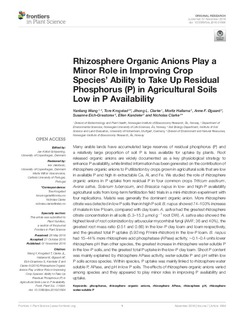| dc.description.abstract | Many arable lands have accumulated large reserves of residual phosphorus (P) and a relatively large proportion of soil P is less available for uptake by plants. Root released organic anions are widely documented as a key physiological strategy to enhance P availability, while limited information has been generated on the contribution of rhizosphere organic anions to P utilization by crops grown in agricultural soils that are low in available P and high in extractable Ca, Al, and Fe. We studied the role of rhizosphere organic anions in P uptake from residual P in four common crops Triticum aestivum, Avena sativa, Solanum tuberosum, and Brassica napus in low- and high-P availability agricultural soils from long-term fertilization field trials in a mini-rhizotron experiment with four replications. Malate was generally the dominant organic anion. More rhizosphere citrate was detected in low P soils than in high P soil. B. napus showed 74–103% increase of malate in low P loam, compared with clay loam. A. sativa had the greatest rhizosphere citrate concentration in all soils (5.3–15.2 μmol g−1 root DW). A. sativa also showed the highest level of root colonization by arbuscular mycorrhizal fungi (AMF; 36 and 40%), the greatest root mass ratio (0.51 and 0.66) in the low-P clay loam and loam respectively, and the greatest total P uptake (5.92 mg P/mini-rhizotron) in the low-P loam. B. napus had 15–44% more rhizosphere acid phosphatase (APase) activity, ~0.1–0.4 units lower rhizosphere pH than other species, the greatest increase in rhizosphere water-soluble P in the low-P soils, and the greatest total P uptake in the low-P clay loam. Shoot P content was mainly explained by rhizosphere APase activity, water-soluble P and pH within low P soils across species. Within species, P uptake was mainly linked to rhizosphere water soluble P, APase, and pH in low P soils. The effects of rhizosphere organic anions varied among species and they appeared to play minor roles in improving P availability and uptake. | nb_NO |

